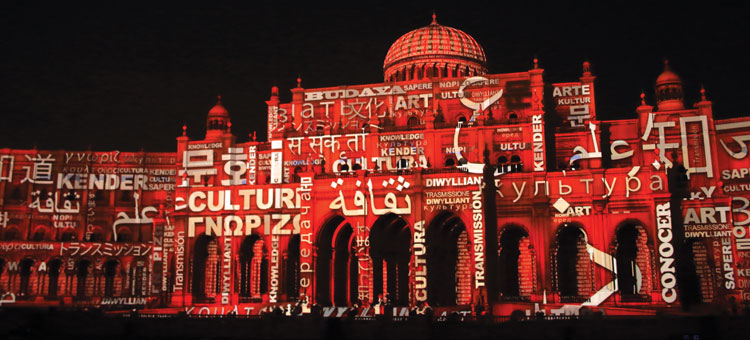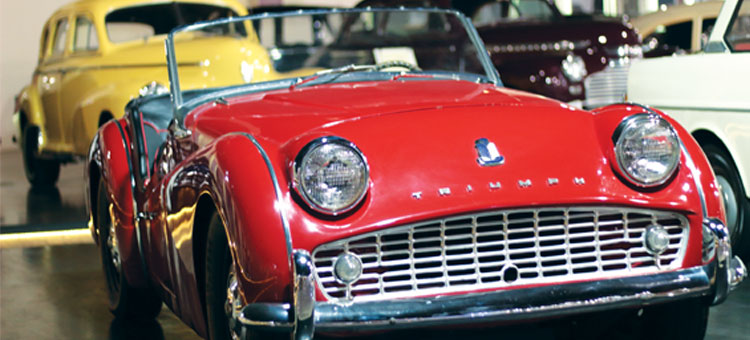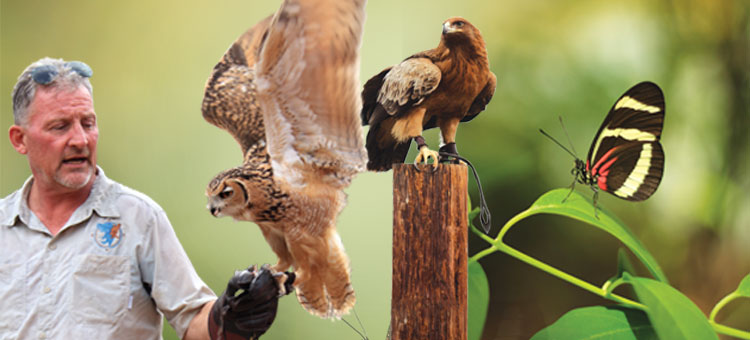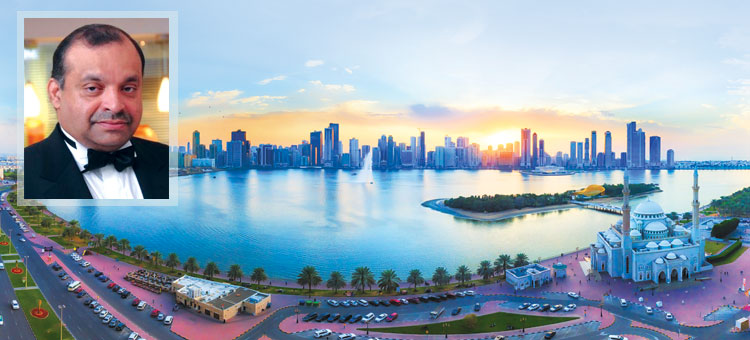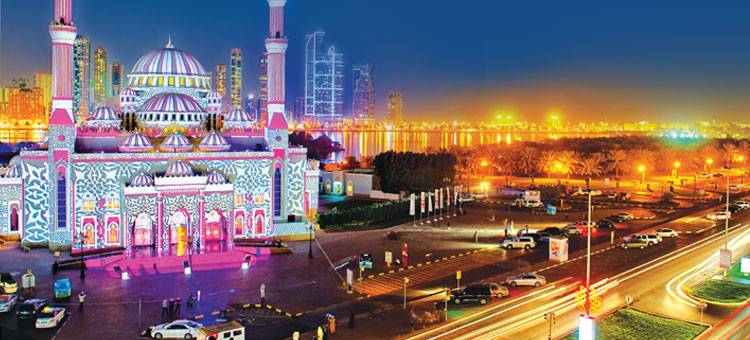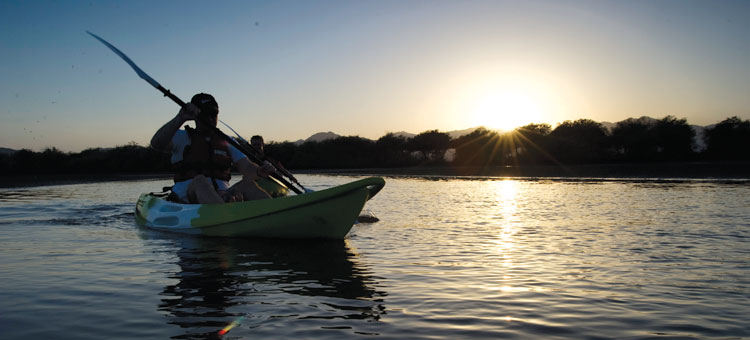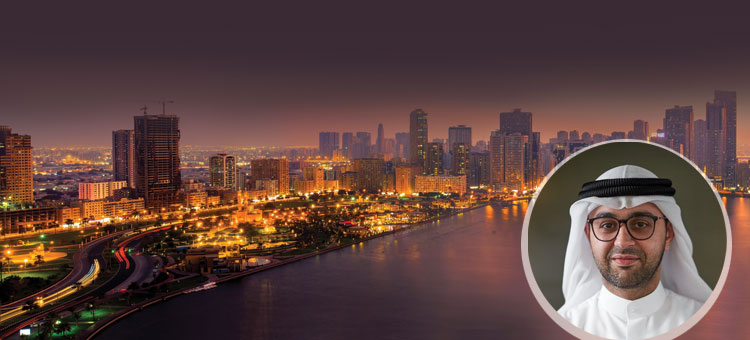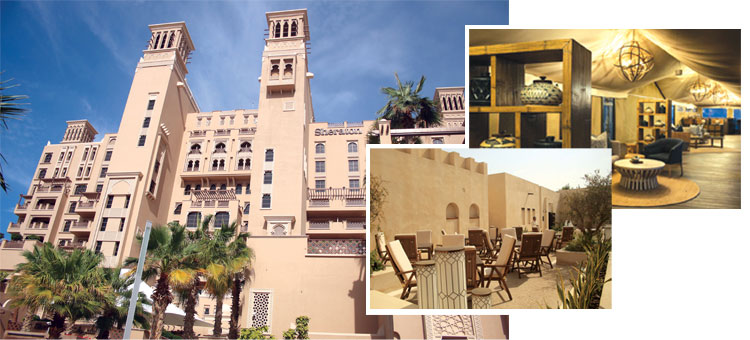Sharjah: Archaeological surveys traced the origins of first villages in the world to some regions in the Middle-East, giving the moniker of Cradle of Civilisation to the region. The Middle-East was thus home to some of the first civilisations on the planet. What followed the golden era of civilisations were subsequent centuries of unrests, some of the fallouts of which still haunt the socio-religious fabric of the countries in the region. A little after the Industrial Revolution, the discovery of oil, the black gold, delivered a great impetus to the Middle-East region. Barring a few countries of the erstwhile Persian Empire, others have lost their significance before the surging Western imperialist interests and owing sometimes to prolonged internal conflicts. The ones which capitalised on oil and gas managed to lay the foundation of solid economies which would later go on to become wealthy nations, driven by businesses.
The radiant spectacle of Sharjah is hard to fade away from the memory of any visitor who gets a chance to witness the Sharjah Light Festival which swathes the cityscape in mesmerising hues. Exploring the emirate helps the traveller discover a blend of modernity and traditions that the ‘Cultural Capital of the Arab World’ has to offer
These were some of the thoughts that went through my mind as I was travelling to Sharjah in the UAE. The reader may be curious to know how these facts are related to the story of tourism in Sharjah. Until a couple of decades ago, the only places of interest in the Gulf region for travellers from across the globe have been a handful of destinations like Dubai, Cairo and Jerusalem. In the UAE tourism played only an insignificant role in the past. Rarity of cosmopolitan hospitality and stringent socio-religious codes often prevented the travellers from choosing destinations in the Middle-East for vacations.
But the pattern has seen drastic changes for good in the recent decades. When Dubai became the world’s hub for shopping and hi-tech extravaganza, Saudi Arabia, too, found it imperative to catch up with the world. Some of the major progressive changes that happened in Saudi Arabia were the royal decree granting freedom to women to access government services without the consent of the guardian, and permission to drive vehicles.
Abdulla Saleh Al Hammadi, Director of the National Tourism Programme said, “Connectivity, hospitality, activities and new attractions have always ensured that the UAE remained a top tourist destination globally. With three international airports, four national carriers, over two lakh hotel rooms, exciting activities for all segments of travellers from family to leisure to sports to MICE to honeymooners, and new attractions being added every year, UAE has been able to retain the interest of global travellers who visit and revisit our land.”
I began wondering what Sharjah has in store for tourists. The unique cultural identity of the third largest emirate in the UAE is visible in its very fabric of life, people and infrastructure, which also in a way portrays the essence of its social and cultural transformations over the centuries. Rightly so, the UNESCO® declared Sharjah as the cultural capital of all ‘Cultural Capitals of the Arab World’ in 1998 while the Islamic Educational, Scientific and Cultural Organization (ISESCO) declared the emirate as the Islamic Culture Capital in 2014. Although the quirks and quiddities of Sharjah at first glance may resemble modern urban realms, the not-so-busy streets would slowly give way to unique architectural marvels dotting its landscapes. This include popular souks, mosques, museums, markets, canals and waterfront jetties mooring sail boats resembling Dhows built in Kerala’s Beypore. Sharjah has earned the unique distinction of being one of the UAE’s most prominent cultural hubs.
Abdulla Saleh Al Hammadi, Director of the National Tourism Programme said, “With three international airports, four national carriers, over two lakh hotel rooms, exciting activities for all segments of travellers from family to leisure to sports to MICE to honeymooners, and new attractions being added every year, UAE has been able to retain the interest of global travellers who visit and revisit our land.”
“UAE continues to enamour the Indian traveller, and to a large extent, is the first international holiday destination to many Indians,” said Sunny Augustine, Executive Director, White Sands Tours & Travel, UAE. With approximately 21.87 million Indians embarking on outbound travel, the India outbound story clearly displays great potential. In 2017, 2.6 million Indians visited the UAE, a growth of 13 per cent compared to the previous year.
I landed in Sharjah at around midnight. The sights of Sharjah began to slowly unfold in front of me as I was taken by cab to the Sheraton Hotel at the bay bordering Ajman. For the traveller in me, those sights provided a new perspective about the world. Next morning I woke up as sun began shining on me through the curtain nets of my room, inviting me to sip a cup of black tea standing on the balcony overlooking Sharjah. What I had expected to see were high-rises all around me. Sipping tea and listening to Frank Sinatra’s ‘Summer Wind’ playing in the background, I saw thousands of beige-coloured Arab households, fenced by tall brick walls, mosques and towering minarets, and pigeons flying around them. It was a perfect setting to begin my three-day stay in Sharjah. What awaited me in the city was the spectacular Sharjah Light Festival, the Rain Room, Sharjah Classic Car Museum and Kalba Birds of Prey Centre in Fujairah.
Tourism in Sharjah
In 2017, the emirate welcomed 1.8 million guests, who stayed in 102 accommodations, 56 of which were hotels while 46 were hotel apartments. The first quarter of 2018 witnessed an 8 per cent growth in the arrival of guests. “The total number of visitors to the emirate is much more but we report only the number of hotel guests as only that can be recorded accurately,” said Khalid Jasim Al Midfa, Chairman, Sharjah Commerce and Tourism Development Authority (SCTDA). Sharjah has over 10,000 hotel rooms in the classified category and is planning to add 5000-plus rooms in the next three years. “All sanctions are in place for the new hotel projects,” he added. According to SCTDA data, the average occupancy is little below 80 per cent and the average length of stay has been increasing year-on-year. “The average length of stay was 1.9 days a few years back and in 2016 it was 2.1. In 2017, it reached 2.3 days. We are witnessing a gradual increase in the figures.” The major source markets are GCC, Russia and CIS, India, China and Europe, in that order. “Every week 1070 flights are being operated between India and the UAE with an average load factor of 95 per cent. This will give you a broad idea about the number of travellers we host from India,” said Al Midfa.
Sharjah mainly targets families and business segments. In 2017, the emirate hosted 3000 events, both big and small. “All the events are suitable for families and this is our USP. We want to grow our tourism receipts but without compromising on our culture and ethos. We want to maintain a balance between commerce and tradition,” he added. In 2015, when arrivals in Sharjah was just 5.4 miilion, the emirates announced its ‘Vision 2021’ programme which aims at touching the 10-million visitors (including hotel guests) mark. Last year, the chairman of SCTDA assured to review the emirate’s performance and recalibrate the target if needed.
“The total number of visitors to the emirate is much more but we report only the number of hotel guests as only that can be recorded accurately,” said Khalid Jasim Al Midfa, Chairman, Sharjah Commerce and Tourism Development Authority (SCTDA).
Sharjah International Airport currently has the capacity to manage 10 million arrivals but it is already handling 11.3 million travellers. An expansion programme costing AED 1.5 billion is underway and the revamp of the airport will be completed by 2022. Sharjah’s vision for what could be the largest safari park project outside Africa is also getting closer to becoming a reality. Named Sheikh Al Bardi Park, it will be spread over an area of 14 sq. km. (about 3,500 acres). Once completed, it will be transformed into a wildlife safari park that contributes to wildlife conservation efforts, accommodating up to 50,000 animals.
The plan is part of a comprehensive strategy to transform Al Dhaid area into a tourism destination while expanding Sharjah’s endangered wildlife breeding programmes. In 2016, Sharjah opened the new 12 sq. km. (3000 acres) Al Hefaiyah Mountain Conservation Centre in the Hajjar mountains to the public. Other wildlife reserves and centres opened to the public include the Wasit Wetland Centre in Sharjah city, Kalba Bird of Prey Centre near the emirate’s east coast and Arabia Wildlife Centre on the Al Dhaid road.
Hotels and hotel apartments generated AED 694 million in revenue in 2017, up from AED 668 million in 2016. Hotels accounted for about 75 per cent of the total revenue receipts. The new statistics show a remarkable increase in the number of Russian tourists (2,66,068), following the introduction of visa-on-arrival facility in the UAE. Additionally, the number of Chinese tourist arrivals during the same period accounted for a massive 45 per cent of the total visitors, while the number of Europeans entering the emirate climbed to an unprecedented 36 per cent. Developments of a variety of key projects are currently underway in the emirate. Al Montazah Amusement and Water Park will also reopen soon after a whopping AED 100 million renovation.
Light Festival
During the Sharjah Light Festival held between February 6 and 16, city’s landmark buildings are spotlighted by projecting stunning video images on their façades, making it one of the biggest and unmissable shows in the world. The ninth edition of the Sharjah Light Festival featured large-scale light shows, projections and mapping inspired by subjects such as science, creativity, culture and knowledge. The 11-day festival attracted over a million visitors to more than a dozen locations across the emirate, including popular attractions like Masjid Al Noor, Al Qasba and Al Majaz Waterfront. The shows were held daily from 6 pm to 11 pm on weekdays and continued until midnight on weekends. A parade was taken out along the Corniche around 9 pm each evening. “This year we had 20 per cent increase in the number of people coming to see the festival. Last year, we welcomed one million people. This time we deployed laser technology for the first time. We also had live shows at Khalid Lagoon and daily fireworks display,” said Khalid Jasim Al Midfa, Chairman, Sharjah Commerce and Tourism Development Authority (SCTDA). The emirate of Sharjah is well known for its rich cultural heritage. It is a vibrant city with an exciting food and arts scene, a heritage area that is the largest restoration project in the region, various commercial centres and over 22 museums.
TOP 5 Attractions
Heart of Sharjah
The restoration-cum-redevelopment project named Heart of Sharjah is the result of an attempt to highlight the socio-cultural fabric of Sharjah. The Heart of Sharjah restoration project, envisaged as the hub of Islamic culture and Arab architecture which also houses entertainment and shopping facilities, is expected to be completed in 2025. At the centre of the Heart of Sharjah is the Souk Al Arsah, a market place where traders from India, Persia, China and Africa met to exchange goods in the 18th century. It is envisioned as a project to rebuild the historic market place by converting old markets and household settlements into popular tourist attractions – mainly resorts, cafes and souks which sell goods like souvenirs. Another great attraction at the Souk Al Arsah is the kitchen which prepares world famous Omani which is made from exotic spices and rose water. The alleys of classic Arabian souk also have entrances to the Al Bait Boutique resort which was until recently an abandoned royal family Al Midfa household. The maze-like pathways passing between tall wall structures are one of the main architectural characteristics of the building. The architecture, wooden artworks, treasures and ambience of the household, which was revamped as hotel, are more or less retained for providing a rustic Arabian look to it. The wind towers mounted on the walls of the household-turned-hotel remind one of the old Arab method used for re-circulating air within buildings constructed in the deserts of the Middle-East. The Sharjah Museum of Islamic Civilization, Sharjah Animal Market, Al Hisn Fort and a waterfront are located nearby.
Sharjah Classic Car Museum
If you are a motorhead and particularly love classic cars, Sharjah Classic Car Museum is a must-visit place for you. The collection of vintage automobiles is simply astonishing. The cars exhibited here help evoke memories of the world before and after the World Wars. Most of the exhibits are models manufactured before World War II. The amazing range of vintage four-wheelers include a 104-year-old Dodge started by hand crank, 1918-model Ford and 1969-model Mercedes Benz 600 Pullman of which only 25 models were produced a year. The model exhibited in the museum was manufactured for the current ruler of Sharjah, Sheikh Dr. Sultan bin Muhammad Al Qasimi, with customised bullet-proof windshields and window glasses. Different antique models and variants from car manufacturers like Ford, Chevrolet and Benz are on display at the museum which offers a visual treat to the visitors. The collection is not just confined to cars. It includes vintage military grade trucks and motorcycles as well. The 1957-model Bedford RL truck which was used in the UAE for military purposes and 1901-model Scout motorcycles imported from the USA for military use in India are also part of the museum collection. The collection of automobiles of various eras being displayed at the museum is highly symbolic of the changes in perceptions of the people over the last 100-plus years.
Rain Room
Rains never seize to amaze people by their soothing touch. Now imagine this: You are walking in the rain but not getting wet even slightly? And, getting your silhouette of standing in the downpour photographed? Welcome to the Rain Room in Sharjah. The 3D tracking technology enables rain-free movement under the shower which is set up in a 300-plus sq. ft. area in the Rain Room. The Rain Room was installed by London-based arts collective Random International in association with Sharjah Arts Foundation. The Rain Room art tries to explore human beings’ closeness to nature with the help of technology. The facility uses 2500 litres of water which is recycled and circulated to produce shower again. Similar installations were showcased in New York, Los Angeles and Shanghai in the past. Ticket for entering the Rain Room can be obtained online and offline. For more details, visit: http://sharjahart.org/sharjah-art-foundation/projects/rain-room
Be Surprised at Al Noor Island
Al Noor Island is a small isolated island off Sharjah’s waterfront. It has been conceptualised as a place where art meets nature. Here, the visitors come under the spell of the flora and fauna, and the sights of the island. According to the management of Al Noor, it marks the fulfilment of modern values and Arabic inspirations, offering the best experiences in art, recreation and entertainment to family visitors. The Butterfly House on the island is shelter to 20 varieties of butterflies, including Tailed Jays or Green-spotted Triangle, Emerald Swallowtail aka Green-backed Peacock, Pink Rose aka Pachliopta Kotzebuea named after Otto von Kotzebuea, commander of the Russian expeditionary ship Rurik; Gray Cracker aka Hamadryas Februa and more. The Butterfly House is ergonomically constructed to retain humidity and allow light, thereby creating environment akin to their natural habitat under a canopy. The ideal time to visit Al Noor and Butterfly House would be just before the twilight when the artificial lights on the island are switched on making it a fantasy world. For more details, visit: https://www.alnoorisland.ae/
The Bird of Prey Centre
“Of all birds, birds of prey are the most fascinating.” This maybe the thought which lingers on your mind after you conclude your visit to the Birds of Prey Centre at Kalba situated on the border between Sharjah and Oman. The centre is a sanctuary of raptors, which were either seized from illegal traffickers or saved from various places in the UAE. At the Birds of Prey Centre, Gerry Whitehouse-Tedd, Operations Manager and the in-house bird trainer, holds two flight displays of 18 raptors a day. Some of the raptors which demonstrate their aggressive sorties are Barn Owls, Short Toad Snake Eagle and Greater Spotted Eagles. “The centre holds raptor flight demonstrations and conducts tour for visitors from schools across the UAE and outside,” Gerry said. The centre was inaugurated by Sheikh Dr. Sultan bin Muhammad Al Qasimi in 2014. When Gerry flashes the piece of meat tucked in his gauntlet, the audience in the amphitheatre gallery frantically ducks in the hope of saving their scalp from the claws of the birds which come swooping down from behind. However, the reality is that the more people duck, the lower the raptor flies. So the key is to stay upright, the bird knows what it’s doing. The centre is also a sanctuary to endangered bird species like Kestrels, Griffon Vultures, Long Legged Buzzards and Lappet Vultures.
Shopping Options in Sharjah
Sharjah teems with shops and markets. ‘Souks’ have been restored and modernised to suit the needs of tourists as well as the local people. Along with these, the emirate also offers many modern malls hosting a range of top brands and entertainment options such as multiplexes, amusement rides and play centres. Sahara Center, situated on Al Nahda Street, is the biggest mall in Sharjah. Besides housing all major global brands in fashion, home decor and electronics, the mall is also known for its movie theatres and popular entertainment centre ‘Adventureland’.
Sharjah City Centre at Al Wahda Road is spread across 38,000 sq. mt. and features over 120 international brands. Here too, one will find a kids’ entertainment centre and cineplex. A recent expansion by adding more shops and dining options and adoption of a sophisticated and contemporary design have made this mall even more attractive.Mega Mall is conveniently located in the heart of Sharjah at Abu Shagara. Opened in 2002, Mega Mall is a major landmark in the emirate’s retail sector and remains one of the leading retail and leisure destinations. It is one of the largest malls in Sharjah at 8 lakh sq. ft. spanning across four floors. It is a wonderland of fashion clothing, accessories and beauty emporiums.
Zero 6 is the emirate’s lifestyle destination. It is a go-to venue for families looking for unique entertainment, leisure, shopping and fitness activities closer to home and under one roof.
Visiting the souks is a great way for tourists to purchase unusual gift items and also enjoy traditional Arabic culture. The souks of Sharjah are unique and charming and ideal places for purchasing goods and souvenirs by engaging in bargaining. The Central Souk, one of the most recognised landmarks of the emirate, can be distinguished by its blue domes. The souk has in store for you fantastic antiques, souvenirs, pashminas, Iranian carpets and a variety of other exciting wares. Souk Al Arsah, the oldest souk in the region, is a must-visit for those shoppers who are looking for a special experience. The souk which was sensitively restored offers a nostalgic atmosphere to the visitors. Yet another lively market area is the Souk Al Shanasiyah, one of the traditional market areas, that has been rebuilt by blending traditional and modern elements. The souk having traditional coral brick buildings is famous for locally-inspired gift items. Souk Al Shanasiyah is located in the Heart of Sharjah, one of the largest heritage developments in the Middle-East.
Air Connectivity
Air India Express and Air Arabia have direct flights connecting various cities in India with Sharjah. Emirates, Fly Dubai, Etihad and Indian LCCs, connect Dubai and Abu Dhabi with various Indian cities as well, so does Air India
Socialise, but No Alcohol in Sharjah!
Emirati Delicacies – Biriyani, Fatoush, Kebabs, Arabian Coffee, fish delicacies and more
What to Wear
The emirate is as conservative as other Arab countries of the region. So don’t even think of going around scantily clad. Moreover, by respecting their sartorial sensitivities a tourist actually pays tribute to the culture of the UAE
Sharjah in a Nut Shell
It is the third largest emirate in the UAE having a population of over 1.4 million. The emirate is being ruled by Sheikh Dr. Sultan bin Muhammad Al Qasimi since 1972 based on constitutional monarchy. Dr. Sultan bin Muhammad is the decedent of Al Qasimi dynasty which has been reigning for the last 200 years. The ruler has banned the sale and consumption of alcohol in Sharjah while there is no such restriction in other emirates.
Best Time to Visit Sharjah
If you want to enjoy the wonderful sights of Sharjah in the right weather, plan your trip between October and April. Visit in February if you want to witness Sharjah Light Festival.
Where to Stay?
Sheraton Sharjah offers five-star luxury and provides tourists the privacy of a private beach on the backyard. Al Bait is the latest five-star hotel in the emirate, located adjacent to the Heart of Sharjah project. Kalba Kingfisher Lodge will be ideal for honeymooners. Kayaking at Kalba Conservation Reserve is an add-on. There is a good chance that you may spot migratory birds and endangered species.
Things to keep in mind
- Dress conservatively for the world is not flashy here
- Do not turn your camera to local people, especially women and children. Local people are sensitive to being photographed
- Bargaining is the key to getting the best price in souks
- Most people understand Hindi and English
- It’s perfectly safe to walk around at night. Public transport is available round the clock
- Young girls and boys don’t mingle in public and staring is not allowed. People of different nationalities such as Filipinos, Africans, Pakistanis, Indians and more are working here
- Carry your passport and visa with you all the time


